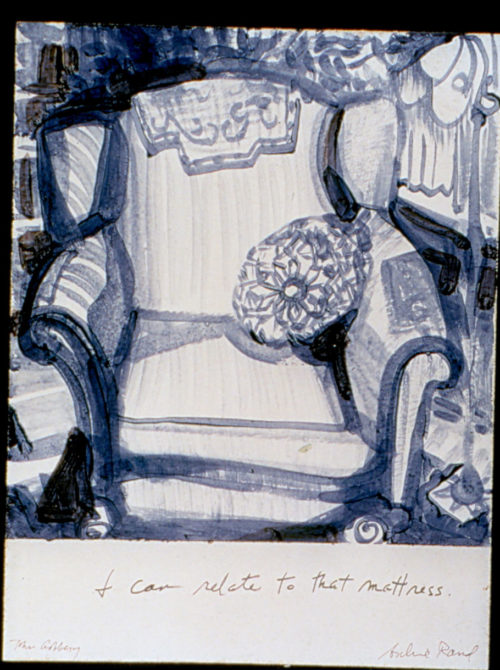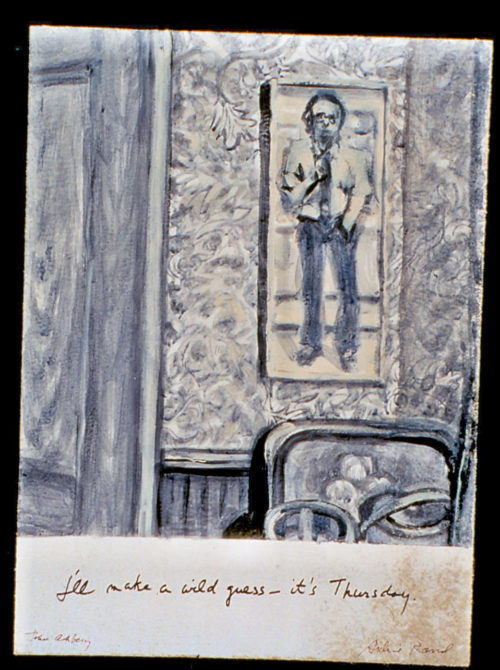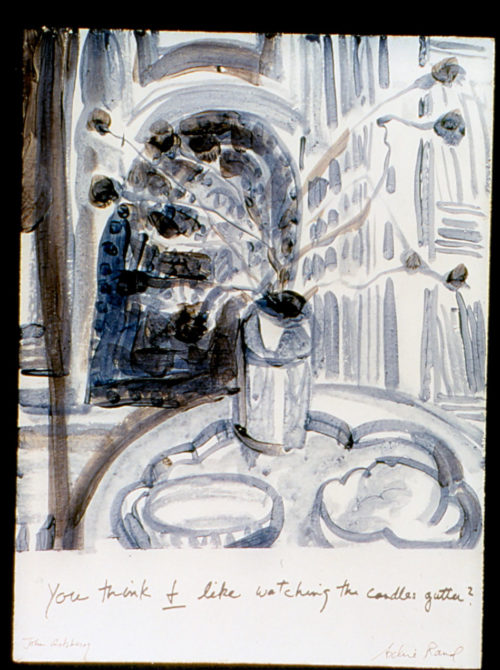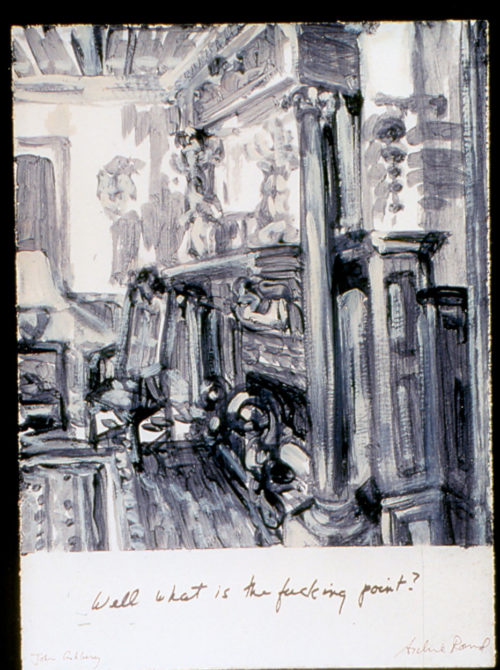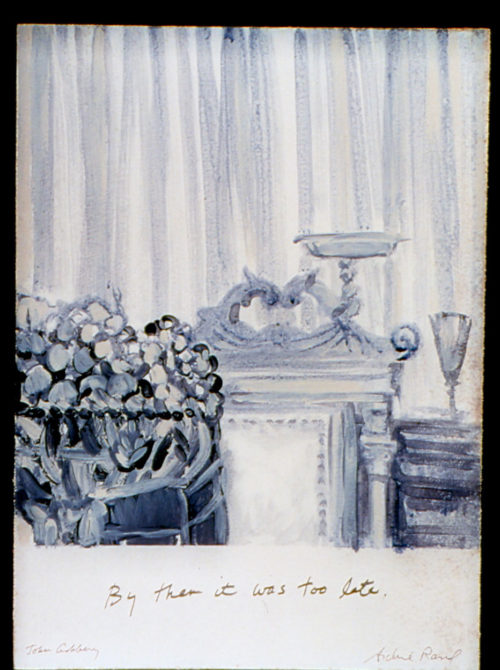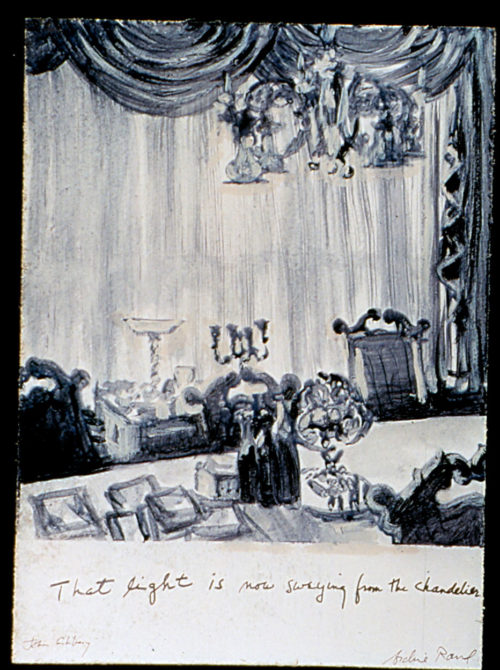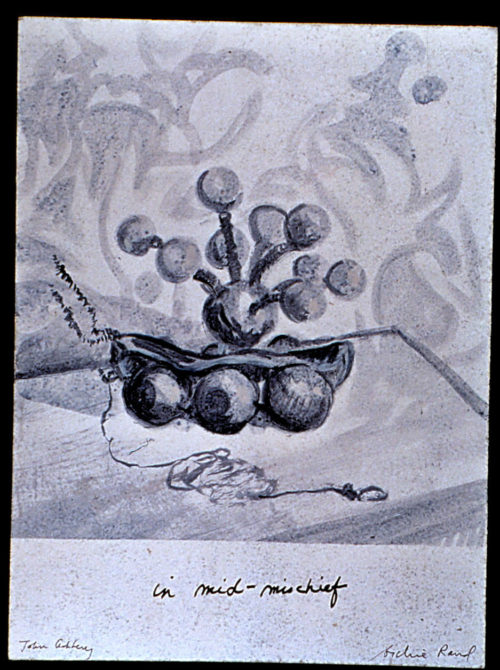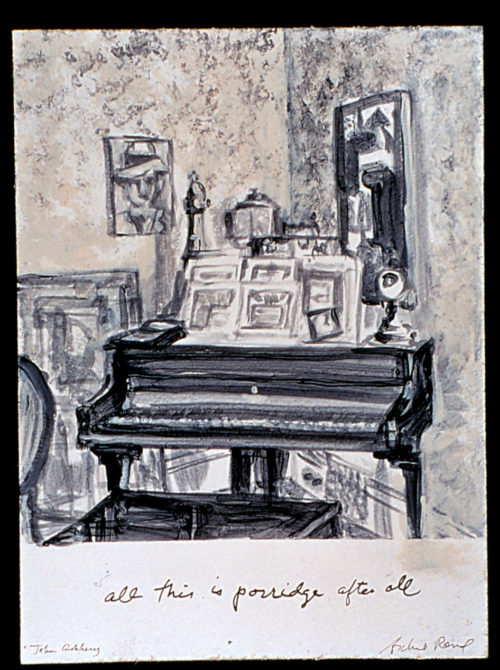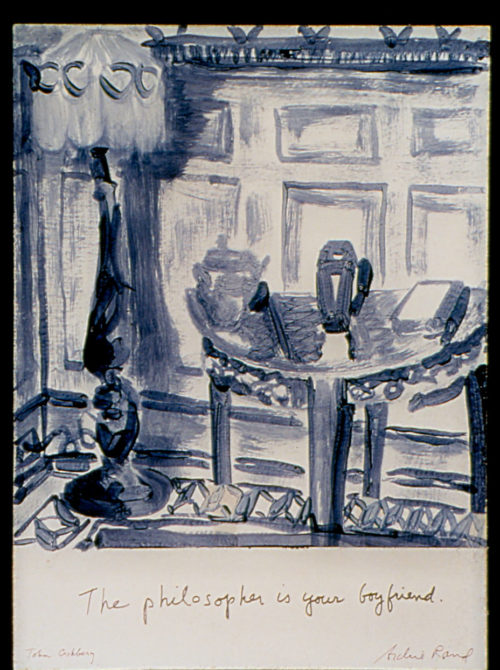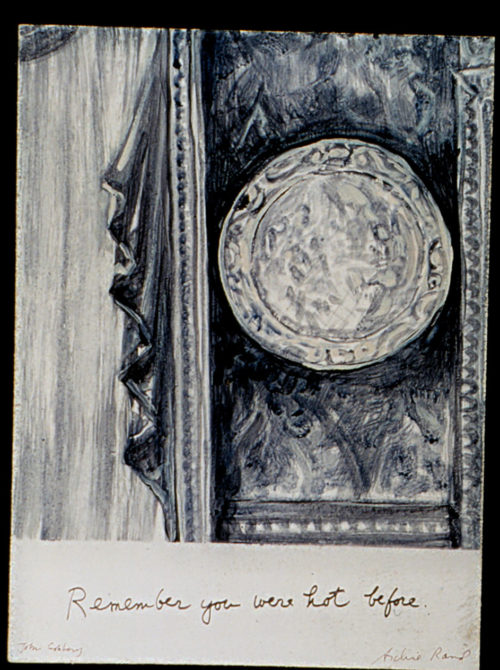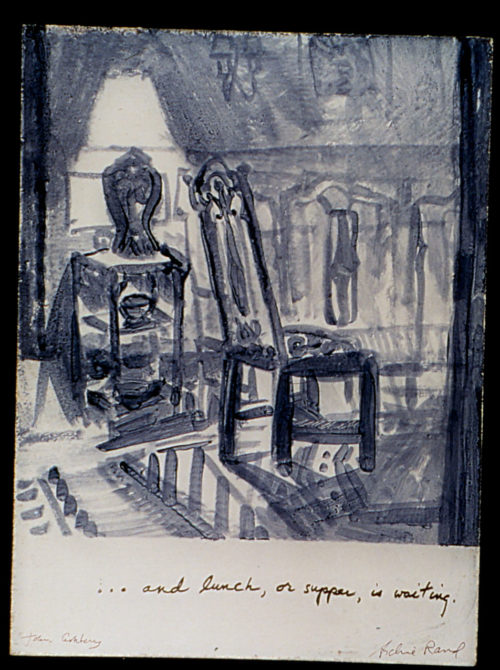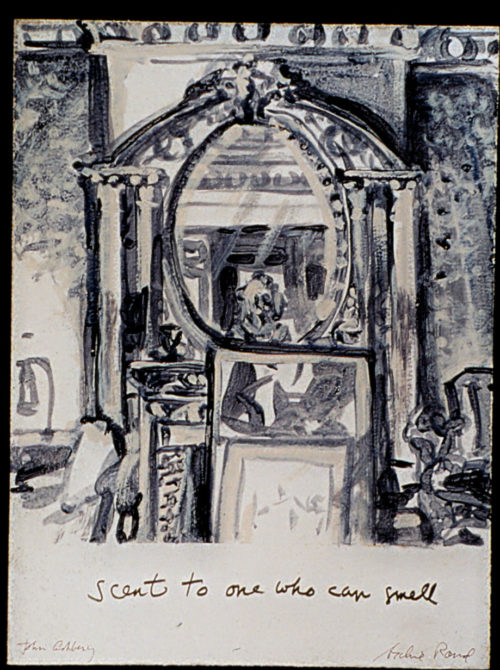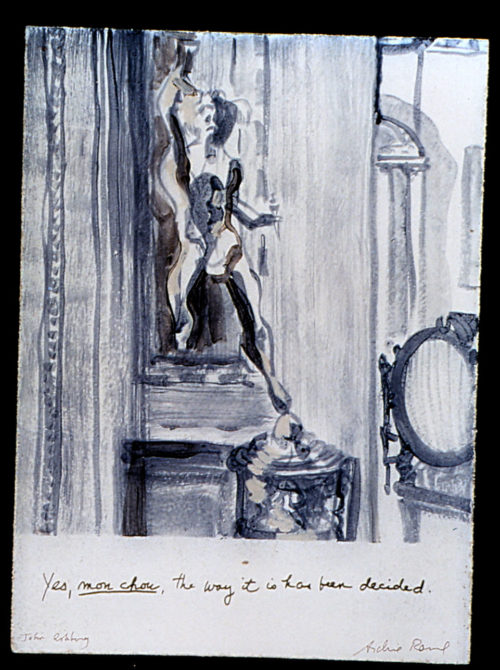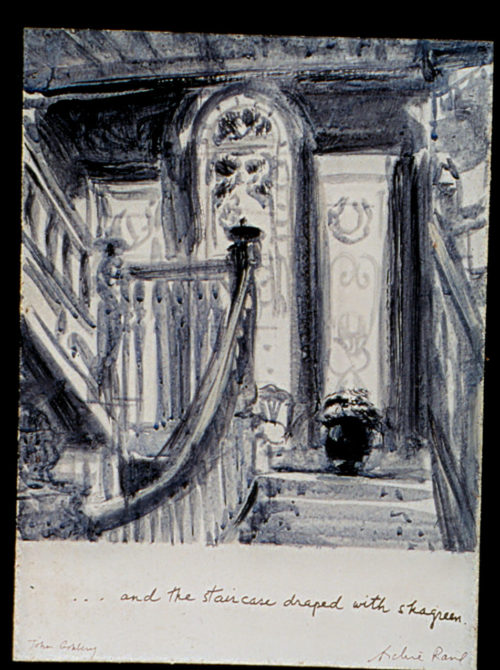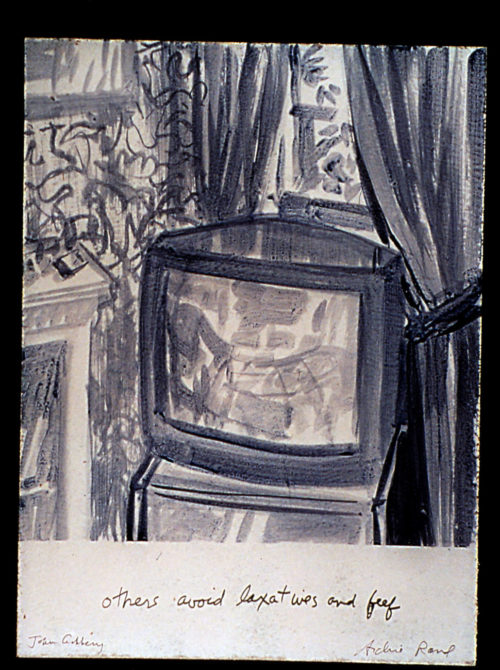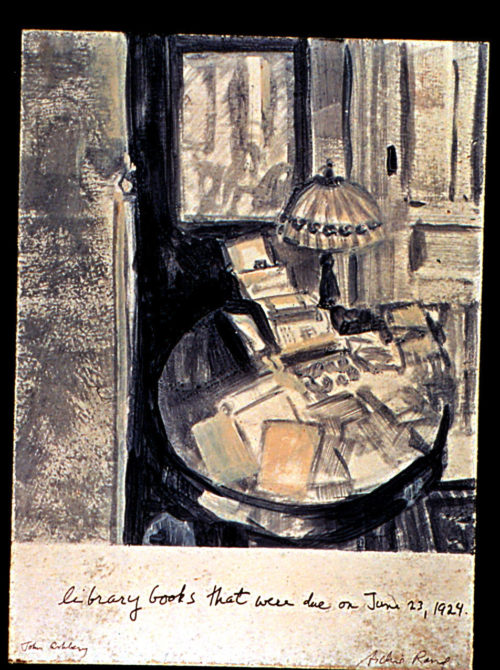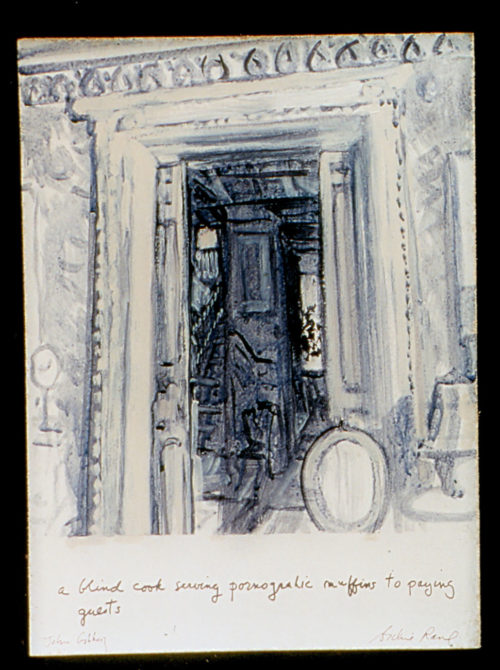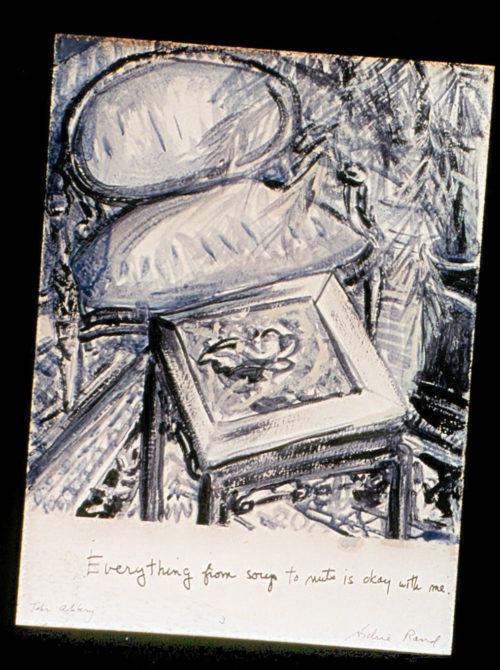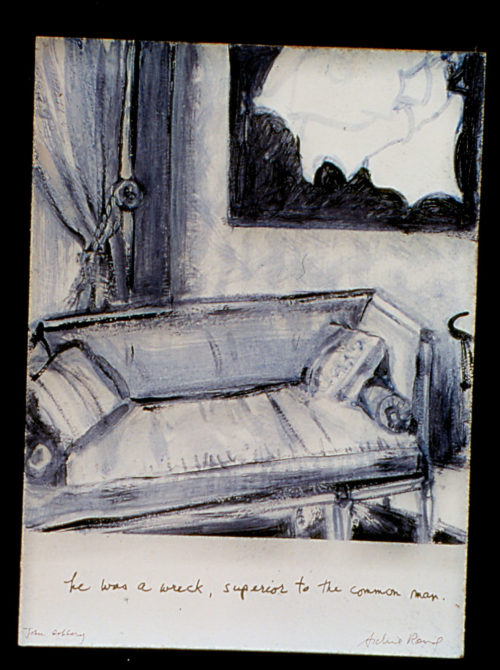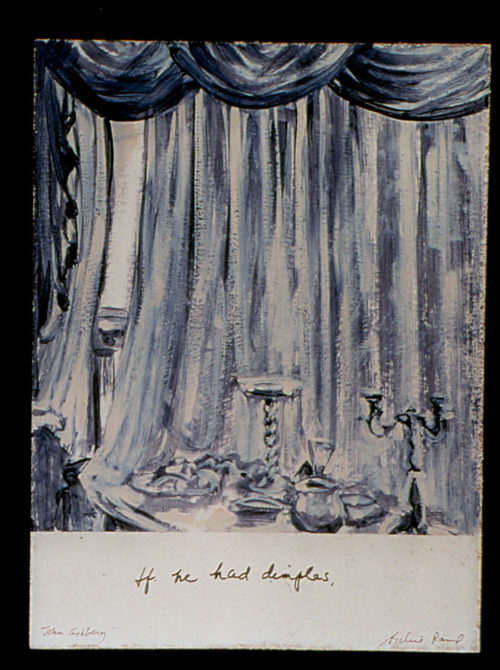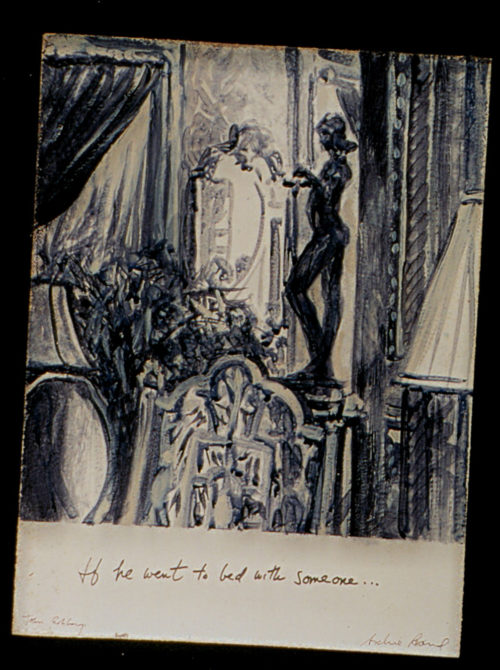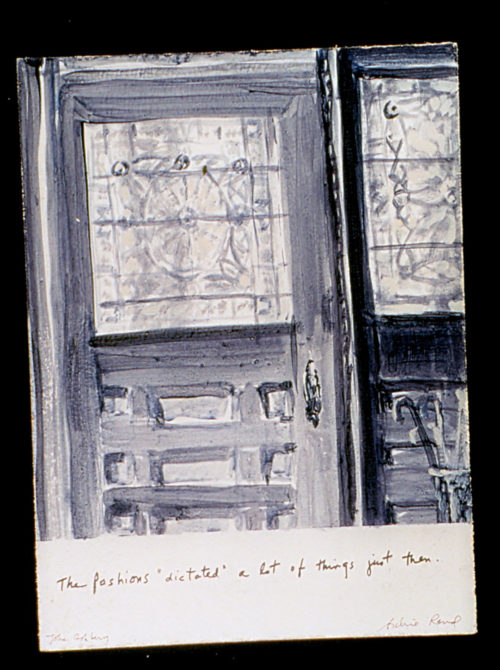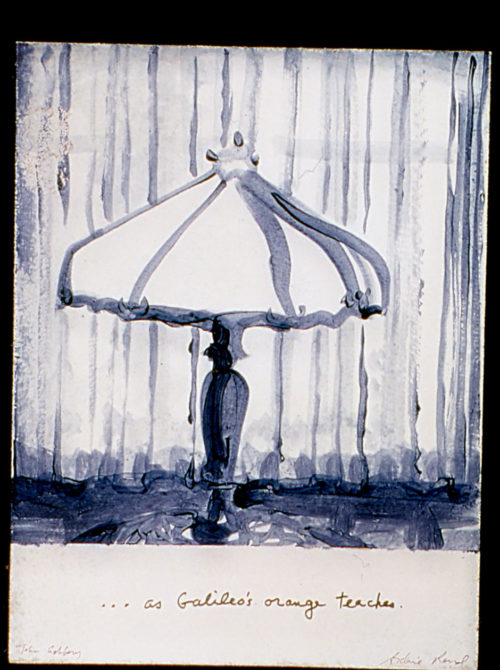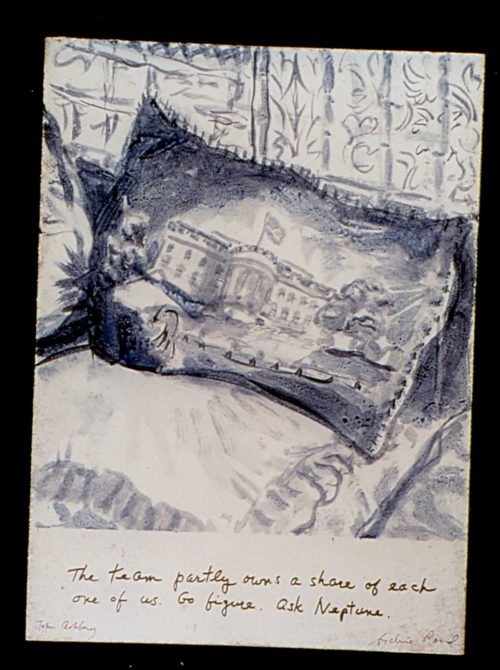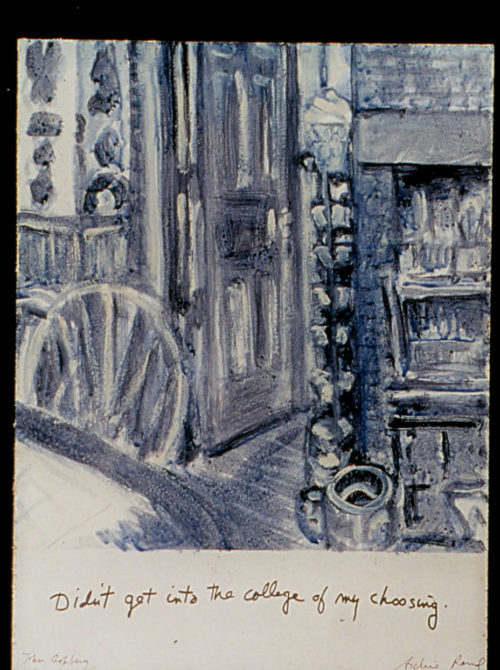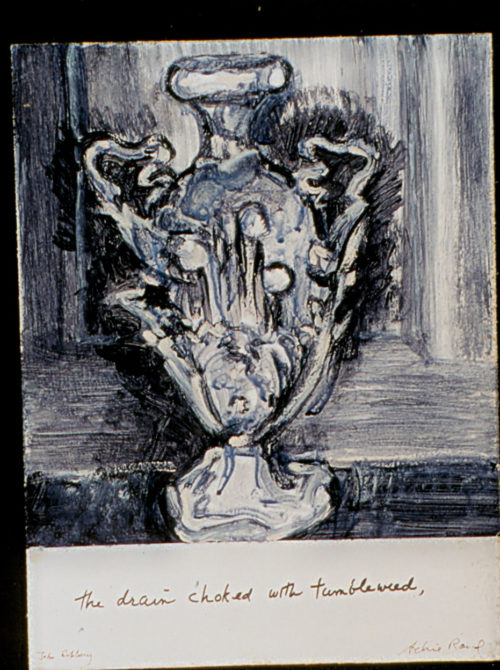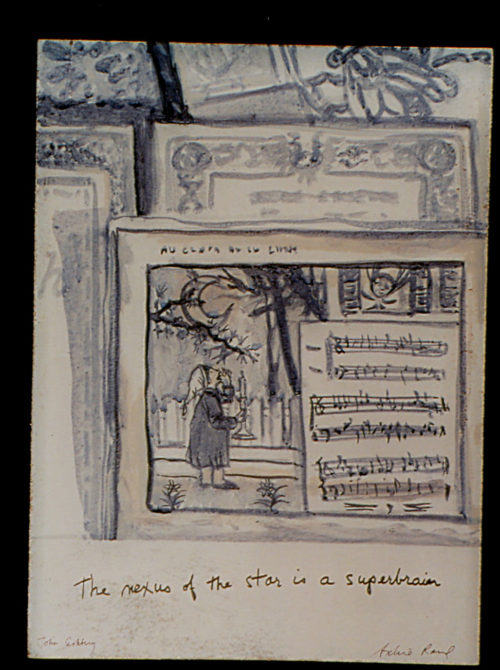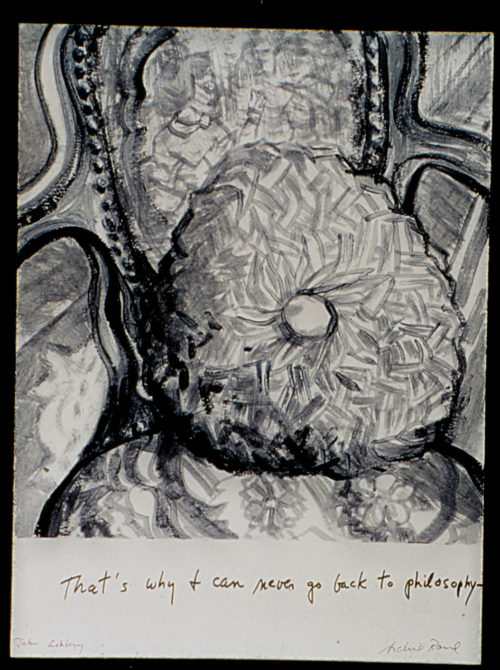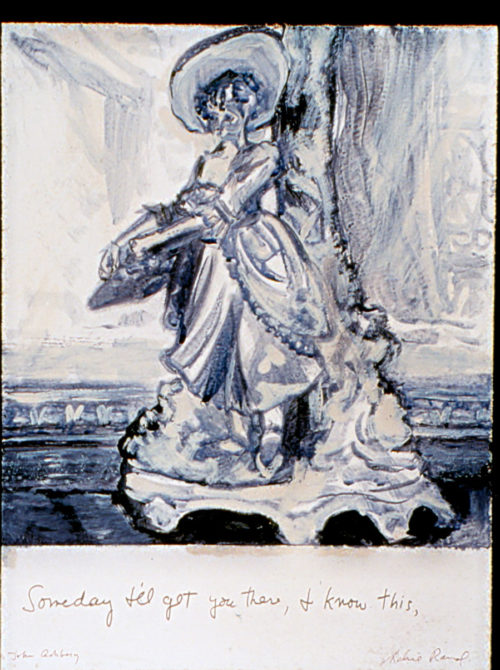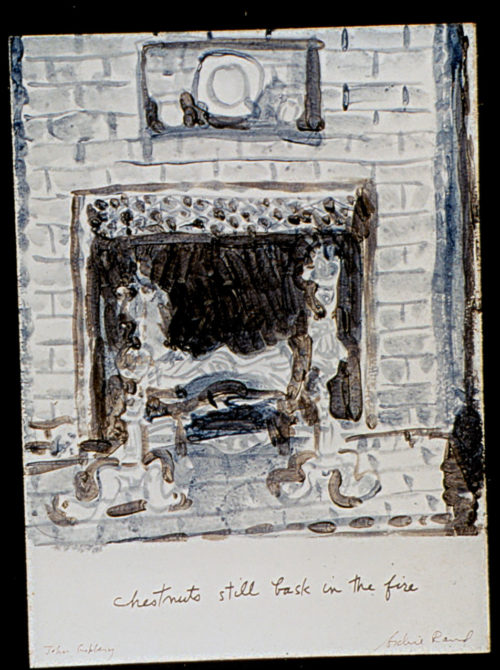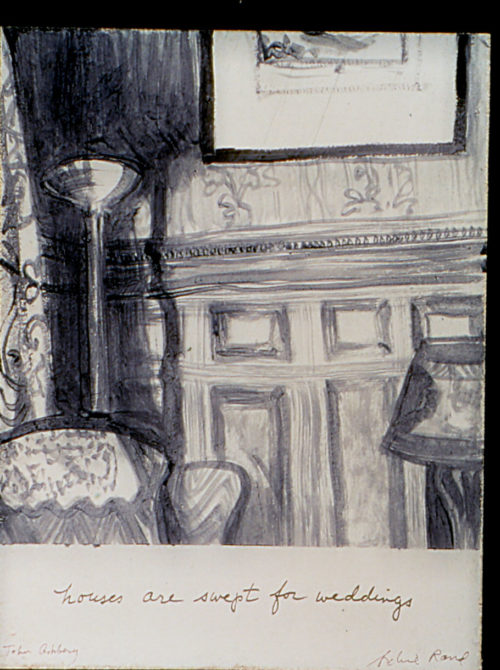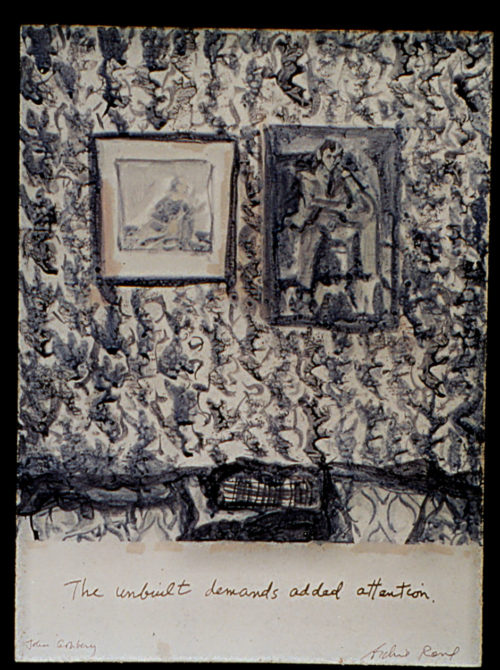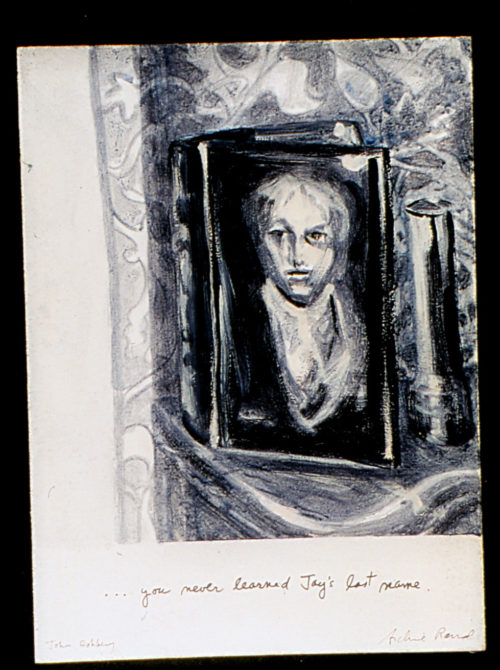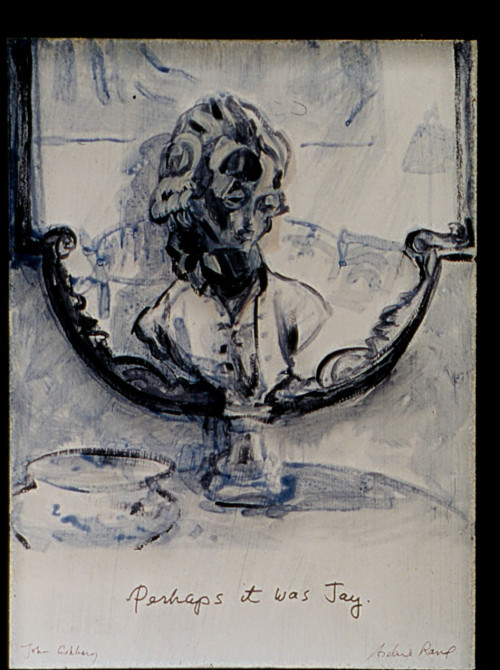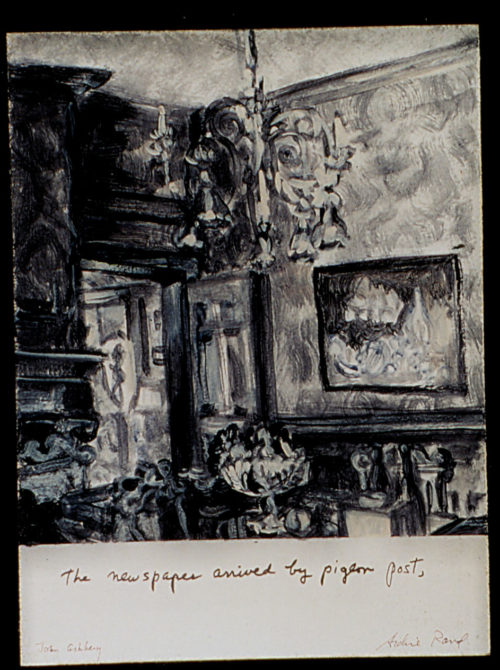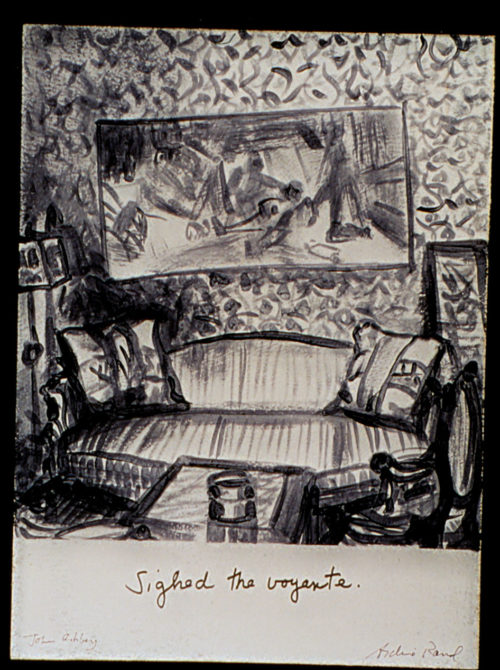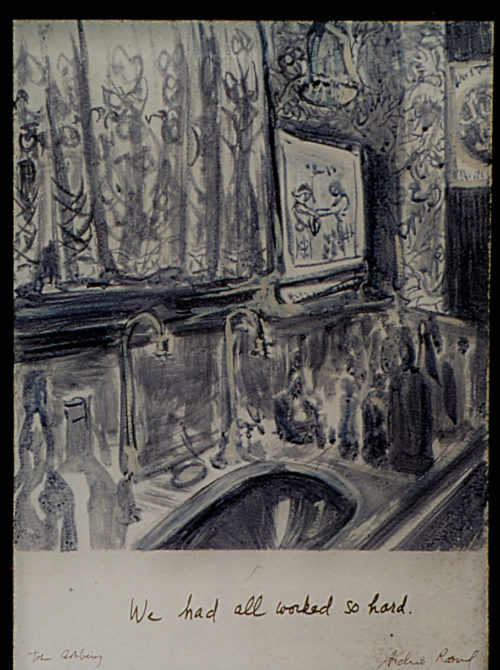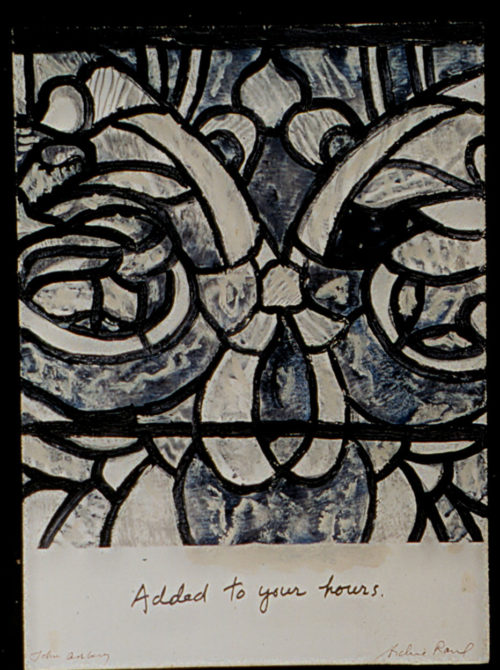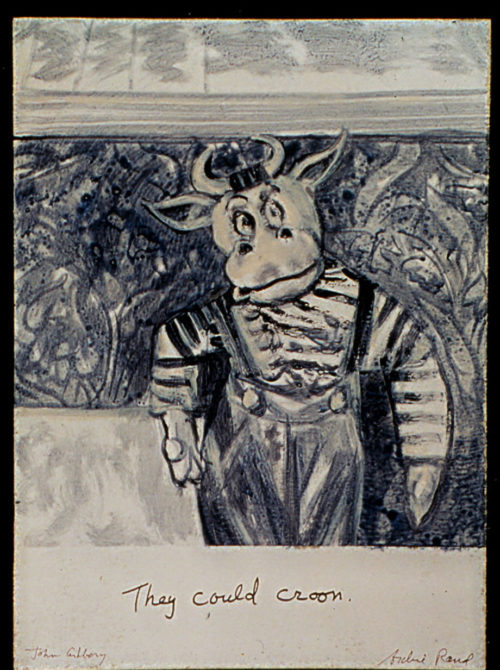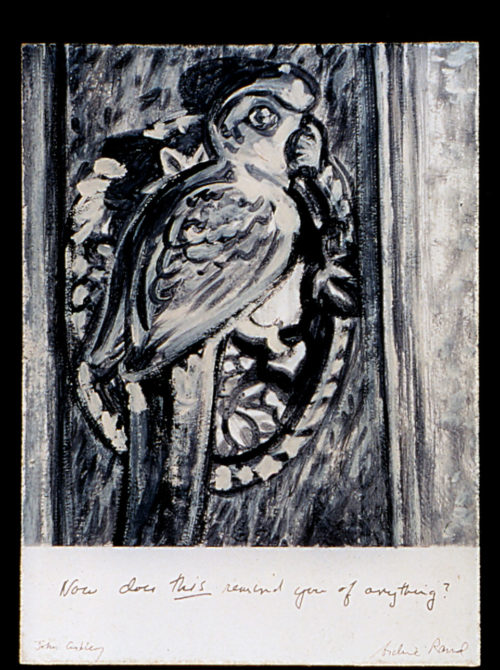by Micaela Morrissette
In 2001, the painter Archie Rand undertook a collaboration with John Ashbery balanced on the fulcrum of Ashbery’s poem “Heavenly Days.” Rand’s labor of love demanded the creation of forty-seven acrylic-on-Masonite panels depicting details and vistas in Ashbery’s Hudson home, the house that Rand identifies as the place from which the voice of “Heavenly Days” speaks. When the series was complete, Ashbery selected lines from his poem to inscribe at the bottom of each panel. Monochromatic but full of subtle cloud-shifts; playful and staid; dazzling and dark: the paintings recreate Ashbery’s home, its bustling clutter and sighing shadows, haughty windows and furtive corners, inanimate hobgoblins and rustling wallpaper, with nimble, graceful affection.
Rand is an internationally exhibited painter from Brooklyn, New York. The veteran of over a hundred solo exhibitions, he is equally well known for his works in murals, in extended series, in collaboration, in a Jewish thematic, and/or in a comic-strip vernacular. Artforum has dubbed him “the most ambitious and more importantly, the most accomplished painter of his generation”; his works are represented in the collections of The Metropolitan Museum of Art, The Museum of Modern Art, The Bibliothèque Nationale of Paris, The Israel Museum of Jerusalem, The San Francisco Museum of Modern Art, The Art Institute of Chicago, The Tel Aviv Museum of Art, The Victoria and Albert Museum in London, and elsewhere. Following his chairmanship of the Columbia University Department of Visual Arts, where he received the Presidential Award for Excellence in Teaching, Rand became Presidential Professor of Art at Brooklyn College.
Micaela Morrissette: Before we get into the panels themselves, I want to establish some background for understanding your relationship with John, the back story leading up to the Heavenly Days collaboration.
Archie Rand: [In the late 1970s] David Kermani became one of the really brilliant directors of the Tibor de Nagy Gallery, and brought in his special circle, which of course brought John Ashbery’s presence into the gallery. In that way, John and I knew each other, but John has a very private public persona, and we kept a respectful but friendly distance from each other. Then, in 1978, after a brief stint as the “color-field” mascot, I became persona non grata, having just completed a commission [the murals of the B’nai Yosef Synagogue in Brooklyn, New York], which took me a very long time, and which was both religious and figurative. I was disheartened by the experience. I’m glad I did the murals, and I’m proud of the work, but very few of my younger peer painters would talk to me. The older painters, with figurative experience and some WPA [Works Progress Administration] recall, from Olitski to Guston, were supportive, but generally I was not being given very much attention for this work. More than I’d expected, it was a rather taboo thing to do.
Then David called me up on a Sunday morning—my wife and I were living in a fourth-floor walk-up in Bensonhurst—and he said, “Well, Archie, have you seen New York Magazine [where John was on staff as an art critic]? Go out and get it!” So I got in the car, and I think the nearest place where I could get New York Magazine in 1978 was probably Brooklyn Heights or somewhere like that. I picked up a copy, and John had given me a giant spread on the murals. I was overwhelmed with gratitude, and from that point on, I realized that John was a sincere and true friend—not only a social friend, but a friend of the work. And when that happens, you relax tremendously, you give yourself over, knowing that the other person understands. From then on, John and I had infrequent but increasingly regular social meetings.
And I must say also that I had always been in awe of John’s work. His work was very, very, very highly regarded, and also extremely important to me in my own work [see AR’s discussion of his Letter Paintings series, below]. Over the course of time I had been doing numerous collaborations, and I floated the idea by David, initially, that I would really like to do something with John. And John passively agreed, but we really hadn’t come to a vehicle that he thought would be appropriate. And that went on for a couple of years, until one day David called me up and said, “I think we’ve got the poem!” And I said, “Super.” And John in fact was in the middle of writing it, so I knew it was going to be a truly collaborative effort.
MM: I hadn’t been aware that when John was writing “Heavenly Days” he understood that you were going to work with it in the future.
AR: Not when he started, of course. You can’t expect any poet to work like that—you know, as Leonard Bernstein said of himself, “‘Lenny, Why Don’t You Run Upstairs and Write a Nice Gershwin Tune.’“ But someplace, probably near the end of the first draft of that poem, it became apparent that this might be an adequate platform for us to make a third thing of. John was very cautious about this, not having any notion as to what I might do to or with his poem. And I was respectful of that, and stayed back for a while. But although the poem was still in workable form (and I’ve never talked to John about this), I don’t think he modified the poem, thinking visually. I think that John is naturally, among other things, a visual poet, and he probably got to the point where he figured he could let this one out. Rather than “Oh, gee, it’s so exciting to see what Archie is going to do with this,” I think more that he was having a kind of guarded courage at this point. You know, “This seems like a good thing to do, let’s see what happens. I’ll put this one out, and see if it works.”
MM: But when the idea of the collaboration first started to coalesce, the house wasn’t part of it?
AR: The house was not initially part of it. The house was my selection. I think that surprised both David and John.
MM: Do you remember your first impressions of the house, getting to know it as a space?
AR: I knew the house long before I knew the poem, which is why I was able to select the house. Of course I was incredibly impressed at the way it was in such perfect shape and at the way John had been able to add to the house his own tchotchkes, which blended in perfectly with the nature of the space—all of which is a visual symbol.
You don’t have to be a psychologist to figure out that when somebody purchases a house like that and refurbishes it with items that complement and expand the house, that there’s a real symbiosis going on. John and the house have a real relationship, and you can feel that the moment you walk in. This isn’t just a place where you hang your hat; the house in fact is a partner. That’s true of a number of people, but in John’s case the selection of partners is rather unusual and also rather perfect.
MM: From your perspective as a guest in the space, what’s the emotional or physical experience of being in that atmosphere, surrounded by the architecture and the objects that inhabit it?
AR: It’s not just the architecture, and it’s not just the affable things, or the contemporaneous objects that John has been able to acquire to augment the transmissions, but it’s the goofy things that occasionally lie around or inhabit the space. They can be anything from art ceramics to abstract expressionist works, or that wonderful Jean Hélion painting of the man with the hat. The house has all of the formality and the quirkiness that you would uncover in a conversation with another human being.
If you stayed there by yourself, it would take a while to come into correspondence with the house. The house is a bit standoffish, not unlike John’s rather reserved temperament. But as I said before, once you become comfortable with the house, it’s very easy to live in and walk around in. It’s not only friendly and not only accommodating, but it’s generous and sumptuous in its offering. That’s a kind of slow-developing joy, and it’s not the reason, but it’s part of the logic behind my doing the house’s portrait as a kind of perfect triangulation between John and the poem. That is, the house acts, not as illustrator, but almost as master of ceremonies in the enunciation of not just this poem (but this poem particularly), but of John’s voice.
I find the house actually to be a more flamboyant stand-in for the reserved personal presence of John: the house is almost a foil. As such, it can speak about John in another way than John’s poems speak about him. But the house and the poems are very complementary. That’s rather remarkable. And, in my experience, it’s not really usual. Because the house is over the top. Many creative people live in spaces which are obviously personal and function for them. But John’s house is almost a fully populated theater, in which he can make pronouncements and have the atmosphere not only absorb but digest and respond.
When John puts on a record and listens to music, it is the actual house that resounds with the music, not just the phonograph. The sounds play off the walls of that house, and they change how one actually hears the music. I remember one evening when John and David and I were watching a hysterically funny Vincent Price movie [The Last Man on Earth on the 1970s television show The Ghoul], which had been overdubbed with irrelevant and very funny dialogue. The fact of watching that in John’s house, surrounded by some great volumes of literature and some pages of the National Enquirer, made watching that film very different than if I were watching it for pure entertainment value in my own house, or in a more sterile atmosphere. It became an event.
Things bounce off the William Morris wallpaper in that house, things are engaged and metamorphosed by their contact with the house, and what happens in the house is magic. I think that the notion of theater is not too farfetched. Not that every person doesn’t make their house a comfortable place for them to repose and interact with the world, but in John’s case, the stakes are much more extreme, and I think that the house was picked specifically because it paralleled something very extreme in his memory and his desire that had to be manifested, had to be made tangible. And one feels that, walking around or just sitting still in that house.
By the time I had gotten around to painting the house or the objects in it, certain monumental decisions had to be made, and the actual painting was almost a secondary and necessary physical activity to the decision to select the house as the home of this voice. So painting those scenes was a series of individual acts of consummated intimacy with those things that I selected because I thought that they were points on the circumference of this shape that was not only this poem, but this poem colored by John’s voice having written or said it.
John, in fact, after a while, was rather amused—you could see it in his face. And not in a ha-ha way: he was amused in an interested way. I don’t know what he expected (probably he didn’t expect much), but it seemed initially that he didn’t think that I would have the kind of voraciousness that I felt was necessary to complement the enormity of John’s offering. I didn’t think that one could complement that with a little hors d’oeuvre. It had to be met in a way that allowed itself to be involved in a hand-to-hand collaboration. But after four or five paintings, it’s my impression that John was surprised that I was still hanging around.
David, of course, expects the wondrous and impossible all the time. If I had said to David, “I have a million more paintings to go,” David would have said, “Oh, absolutely! That’s wonderful!” John basically watched, as well I could have expected. I’m taking on this thing of his, and he probably was very curious as to what type of response I would have and what that would mean.
MM: How did the poem “Heavenly Days” impact the process of creating these works?
AR: Something tells me this could be a long answer. I’m going to start autobiographically.
My initial aesthetic family, in poetry and somewhat in painting, was those forefathers who liked to come to a point. They liked to have an answer. They were wise, they were adults. These were the people I was introduced to by my dear college friend Ross Feld, who was the poet in my life, and I was the painter in his life. Ross introduced me to William Carlos Williams, Montale, Creeley; also Gil Sorrentino, Paul Blackburn—basically the St. Mark’s Church crowd. They would have poems that came to sage conclusions at the end, and you would say, “Oh, I have been told a great truth.”
When I first met Ross (I must have been fifteen or sixteen years old) he had a Robert Motherwell poster on his wall. And I said, “You don’t want Motherwell on your wall. That’s not saying anything! Take that poster off, and if you like that kind of stuff, put up a Franz Kline poster. Kline actually says something; Motherwell doesn’t say anything.” Ross understood that, and we agreed that there was a parallel between poets who said things and painters who said things, as opposed to this kind of mishmash of aesthetic niceties. These were people who loved bebop and bluegrass and stuff you could actually put your thumb on and hold down: you could find it.
John Ashbery’s poetry was not in the crosshairs of this type of aesthetic appetite. But I had a parallel appetite, which I did not share with my friends. We all had older longings: longings for bebop, longings for Abstract Expressionism. We’re talking about people who were fifteen, sixteen, seventeen years old, looking toward the accomplishments of people who were in their late thirties to mid-forties—Beatniks, and stuff like that. There was a part of me that actually had my foot on a current pulse. There was a part of me that would catch John Coltrane at the Half Note, that would catch Cecil Taylor at Town Hall, that would catch Albert Ayler at Slug’s Saloon in the East Village. At Larry Poons’s house I heard LaMonte Young and a lot of rockers. This part of me was not accommodated by my aesthetic cohorts who roosted at their appointed sections of the bar at Max’s, The Ninth Circle, or St. Adrian’s Company.
When I read Ashbery’s poetry, which I did on my own, because it was not handed to me by anybody in that group, at first I didn’t know how to get into it. Not because it was confusing. I was used to being confused by people like Michael McClure and Jackson Mac Low and the magnificent Robert Duncan. That didn’t bother me. But I was confused sometimes by the length of some of the things I was reading, by the congestion of it all. At a certain point—I must have been maybe eighteen years old—I fell into a kind of passive submission. I allowed the work to wash over me, the way I allowed Cecil Taylor or John Coltrane, or Jackson Pollock for that matter, to put me in a state of humility and simple receipt. When I did that, Ashbery’s poems opened up for me in a way that I found marvelous.
Some of the earliest paintings that I did that were of any consequence were in a series called the Letter Paintings. These were the names of musicians or just the letters of the alphabet that sometimes ranged in length to 150 feet. They were basically scrolls, and as such they couldn’t be seen non-sequentially, and they couldn’t be seen as making a point. The influence of Andy Warhol or Ed Ruscha’s work was operative on me at the time, as were, more so, the accomplishments of the aforementioned Coltrane and Cecil Taylor, and, in the poetry camp, almost exclusively John Ashbery. Which was my secret. This was long before I met David.
There’s something about the people that I’ve been friends with as an artist that strikes me as kind of unusual. That is, if I think of the people who have been my friends, who are artists—the filmmaker Ang Lee; the painter Malcolm Morley; Cecil Taylor, whom I’ve known since I was fifteen years old; Philip Guston—what these people have in common is that they are relentless. Absolutely relentless.
Ashbery’s work—for all its calm and its beauty and its coyness and its profundity of hidden emotion—more than anything is relentless. It’s the relentlessness which makes real the heartbreaking affection, the heartbreaking love in his work. To have that love made available, and so articulate, sometimes can bring you almost to tears.
In “Heavenly Days,” he has a line about a blind cook who serves muffins to paying guests, and soon after, a reference to him serving cocktails. [a blind cook serving pornographic muffins to paying guests / over cocktails before the sea opens and drinks us, and then closes over us, smacking its lips like an idiot] Blindness is something we don’t talk about in our days. “Handicapped,” “impaired”: we talk about disabilities. And we don’t call a cook a cook anymore, we call a cook a chef. Chefs don’t serve muffins today, they serve bruschetta. Restaurants in hotels don’t have paying guests; they have clients. We don’t have cocktails; we have drinks. Instead of saying, “The visually impaired chef serves erotic bruschettas to clients and then we have drinks,” he uses these words which are perfectly okay words, they’re not antique words, they’re just words that are put into a context that takes us back to that place that the house inhabits.
That is, the blind cook is a character that goes with Neptune, who’s mentioned two or three times in this poem. If I had to think of what a blind cook and Neptune have in common it would be Maxfield Parrish—and everyone’s acting like Oliver Hardy. Or Neptune being the bas relief coming out of these seaside resorts around World War I, done in glazed tile. So by the time we get to the next line, in which the sea opens up and smacks its lips like a Max Fleischer cartoon idiot, just by Ashbery’s selection of words the sea that opens up is a sea that is traversed, not by motorboats and speedboats in Miami, but by the Lusitania. That’s the sea that opens up after a blind cook serves muffins and cocktails to paying guests. It’s the sea of the 1920s and the 1930s. So just by mentioning the sea at that point, Ashbery has shown us where he lives, and that’s the house. That’s the voice of the house talking.
It’s the voice of the house. It’s not just picking up objects and being cute. Ashbery can be cute with the rest of them; he can be cute like Kenneth Koch can be cute. But there’s something achingly imperative when Ashbery’s funny. It’s an almost Shakespearean funniness. It’s part of an immense picture, it’s what attracted me to Cecil Taylor’s music, when Cecil will take Duke Ellington and weld it with Stravinsky. Or Jackson Pollock will throw paint on the floor, but he’ll use apple green and silver and lavender. What kind of man paints in lavender? Or John Coltrane gets into a fight with Amiri Baraka in the pages of Downbeat because he’s decided that it’s perfectly okay to play Walt Disney’s Chim Chim Cher-ee because it’s harmonically interesting. It’s the lack of limitation, the lack of stance.
Ashbery’s critics find him encrusted in stance, but what I discovered when I was very young is that it’s just the opposite. Ashbery’s freedom of language is so prodigious that you fall into it; it’s almost frightening how colossal it is. It’s almost the entire world. And the voice that articulates that world has to come from somewhere: it’s not a theoretical voice, it’s John’s voice. And that voice happens to live in Ashbery’s head, in Ashbery’s body, and it happens to be in his house.
MM: I wanted to follow up on something you said in the last couple of minutes about the quality of affection or tenderness that you found in John’s work, and to address that in terms of the art of collaboration.
You’re a famous collaborator, and so is John. In 2002, you participated in an event at Columbia University on poet-painter collaborations, during which you said:
You mutually validate, immediately, each other’s emanation of affection, which is comforting, because you’re only right because someone else has understood your language so immediately that they’ve been able to answer you. . . . The message of the artwork isn’t necessarily what the text or the picture is, the message of the artwork is the tests and the acceptance of an enormous strain on affection. That is, the pictures end up being pictures about faith, rather than about the specific that they’re about.
AR: Of course, I’m not the first person to say that. Anyone looking at Cézanne’s paintings realizes that he never missed a Sunday mass; he was a man of deep devotion and he didn’t want to give short shrift to anything that was God’s creation, including the air. Later, Cocteau says that “poetry is a machine for the manufacture of love, and all of its other properties are lost on me.”
But I actually got that idea when I was reading an autobiography of Paul McCartney. McCartney was talking about collaboration, and he said that when you do something by yourself, even if it gets prestigious rewards and tremendous attention, you never really know if it’s any good. What he implies is that it’s temporary, it’s topical. You can go to your grave with every accolade in the world, and three minutes after you’re dead, nobody cares about you, and nobody cares about your work, and frankly it almost never resurfaces. You can never really tell whether anything you’ve done is any good or not; you don’t even really know what that means.
But when you’re working collaboratively, in order for the person you’re working with to respond to what you’re doing, they have to check it off, they have to actually say, “Okay, this is good, now I’m going to build on that.” And McCartney mentions that that’s the only time that you’re ever validated absolutely, permanently, in the immediate present. That’s the only time you know that what you’re doing is good, and the only reason you know it’s good is that somebody else has trusted it enough to actually fabricate something on what you’ve given them. Therefore, it must hold up. And I thought that was really, really interesting.
MM: This collaboration with John is different from other collaborations you’ve done. For example, Drawn & Quartered, your collaboration with Robert Creeley, was more immediate, wasn’t it? You were passing things back and forth; it was more rapid fire.
AR: Not really. Creeley had seen photocopies of the work first. But I was sort of staggered, it was like being punched to death by Mike Tyson, watching Creeley rock them off, these incredible poems, under these pictures I snootily thought were self-sufficient, and I would allow Creeley basically to title them. The pictures became a pile of dust under Creeley’s four-line pummeling.
I was very grateful for that, because when the artist works with the poet, the artist should know that the artist always has the home-court advantage. People look at pictures differently than they read. You could be working with Shakespeare, and the worst artist in the world could beat the shit out of Shakespeare, just because people look at pictures differently.
The work with John Ashbery was very much in keeping with Ashbery’s cautious personality. That is, I did the work, he watched me do it, and I’m sure while he was watching he was thinking about what types of responses he would have. The more I watched him seriously considering this, the more I tried to make the work more specific to what I sensed is the truth of what I just said about objects and architecture in Ashbery’s house: the characters that needed to speak. So the kind of collaborative work that we were doing was very real, but it was done on a much more telepathic or psychic level.
I’m not saying that in a flip way. Sometimes you read something where the artist says, “Oh, I didn’t read the text,” and the writer says something similar—that’s just putting two pieces together. Both John and I approached this very respectfully, and with an appropriate amount of trepidation as to how or if we could pull something off and make another thing that was different and possibly bigger than the individual lines of poetry or the specific little quips of painting.
I tried to vary my painting style with a somewhat 1950s modernist representation. But mostly I tried to hold the paint handling to a kind of William Merritt Chase sketch mode, keeping the feeling of the paintings within the architecture and maybe the voice that John inhabits.
It’s interesting that John doesn’t talk about the house reminding him of something as immediate as his parents’ place. He talks about his grandfather. So when you’re talking about John’s grandfather’s house, you’re talking about projecting yourself very far back, you’re talking about projecting yourself back a century. So you’re not talking about a strategic positioning of voice, the way all of my friends were strategically positioning ourselves to be the youngest of the Beatniks or something. John basically did what Ross Feld later said about me, which took me by surprise. Ross said I had a pre-modern sensibility, and what attracts me to John’s work, and what attracts me again to both Coltrane and Cecil Taylor, is that there’s something in Coltrane which is pre-modern, there’s something in Cecil which is pre-modern. Cecil’s unpredictable improvisations could be an extension of what Chopin did, and Coltrane’s improvisations could be an extension not just of Sidney Bechet, but of the whole New Orleans enterprise, maybe even before or concurrent with early Jelly Roll Morton.
John’s voice, not only in his language, but in his references, goes back to a place before records of modernism were kept, almost a pre-century or a turn-of-century place, before this race went on to see what avant-garde could supplant the next. The comfort of that voice is as recognizable as the loneliness and futility of that voice. That is, that voice isn’t in the running. And that’s where it links up with the sensibility I initially started with, the sensibility with the Beats and with bebop and with great masters like Eugenio Montale. There’s a melancholy which is not manic and it’s not hysterical and it’s not there for sympathy, it’s the actual color of the speaker’s voice, and there is nothing more profound or more helpless than that kind of knowledge.
The place where I met John Ashbery was on that horizon line. It’s a horizon line as bleak as the last paintings that Mark Rothko did, but it’s a place where you can actually put your feet. It’s a place which has an almost polar blackness to it. It knows it has to live and it covers itself in oranges and browns and warmth and the necessity of friendships. And all of those things, from the earliest age, are flavored with asked-for and willing knowledge of one’s own mortality. That’s staggeringly heavy. It’s like, “Come on, it’s a poem and there’s pictures and you guys got together.” No. What John and I agreed on is the humor or the absurdity in the obligations and the nobility of the entire trajectory of living a human life. It’s prodigious.
When I think of it now, it’s kind of strange. I’m painting whole sections of interior, or I’m painting little close-ups of things. There was really no logic I could break down after the fact as to specifically what it was I was painting. But there was an organic necessity to get certain distances on things, to pick out certain types of objects, to paint them a certain way.
I remember I was in the low forties at one point, painting number forty-one or forty-two, and John said, “How much more do you have?” And I said, “I think four or five more and I’ll have it.” And he understood that. He said it with a smile, but when I responded there was a look of grave acknowledgement on his face. That is, by the time it had gotten to that point, John knew exactly not only what it was that I was doing, but what we were doing.
I’m reminded of an interview that I read once, with Elvin Jones, the great percussionist. The interviewer said to him, “How do you know how to construct your solo?” (I remember Cecil Taylor once said, “If the music is true, the form takes care of itself.”) And Elvin said something really remarkable. Elvin said that when he sits down to take a solo—and sometimes Elvin’s solos would go on for half an hour—he closes his eyes and he sees in his head a geometric pattern. And as he plays, each segment of the pattern fills in, almost as if with a pencil. He knows the solo is over when the entire pattern has been filled in. That’s almost exactly how I responded to John’s poem with these paintings.
So when it came time for John to make the selections of text, he went about it in a highly serious and very professional manner. He laid the pictures around, rearranged them, picked out certain lines from the text, decided which ones would go where, which is exactly what I was doing with his poem. That is, I would be hearing certain rumblings of something, and I would think, “What situation in this house represents this kind of rumbling?” And without necessarily narrowing it down to one line equals this picture, I knew I was capturing some kind of emotional or psychological specific in each point of view, in where I placed the angle of my eye, looking up at something, down at something, looking across at something, diagonally, straight, close up. All of these decisions had to do with almost being a cinematographer or a film director. “Okay, this voice comes from this place. This object could be saying this, in this context. This character would feel this way in this matrix.”
MM: John couldn’t have been so very surprised at the number of paintings that were developing, since you are known for the lengths of your series: the 613 mitzvot canvases, Sixty Paintings from the Bible, your fifty-four Parsha Paintings, the thirty-six paintings of Psalm 68, the thirty-one images in Nachmanides’ Letter to His Son, the twenty-four paintings for Gods Change, Prayers Are Here to Stay, your Nineteen Diaspora Paintings, your Letter Paintings—as well as for projects that are smaller numerically, but still serial in nature: The Seven Days of Creation, the ten Had Gadya Paintings—and so on.
When Heavenly Days is taken in the context of those other works, and when it’s described as a series of paintings that plays with the panel of the comic strip and with the intersection between pop and high art, it seems strongly to resemble your other projects. But looking at it, based solely on a quick visual reaction, it seems to stand as a thing apart. Could you speak about the way Heavenly Days relates or does not relate to your ongoing concerns as an artist?
AR: Usually the texts that I deal with, with very few exceptions, are texts that I receive cold, that I have a philosophical affection for, but I don’t have the warm-bloodedness of interaction. There are exceptions I can name, such as the collaboration with John Yau, where we sit there and we sputter goofily at each other while we turn out this stuff. It’s great fun and it makes another kind of product. The spontaneity is in fact not only evident, but is the content of the product. It was different when I worked with Creeley, where I started out in one way, and Creeley was sort of this hammer that fashioned it into something else, for which I’m very grateful. I use my passivity as a launch site so I don’t really see myself as a pontificator while Creeley, and Yau, and Kennneth Koch and maybe even Clark Coolidge, and other people that I’ve worked with are people who can in fact say something. I count on that.
Ashbery and I have something in common. The barrage of information that we have is a character that carries the message of unfocused and almost dejected affection. Ang Lee said something really interesting to me a couple of years ago. I said to him, “You know, you’re a filmmaker and you deal with these huge budgets and you deal with lots of people, and I basically just lock myself in a room. I’m very grateful that we’re friends. I wonder what deeper things we have in common.” Ang is a beautifully wise person. He’s an extremely private person, which I think is a basis for our friendship. He said to me that I shared with him a quality that he would probably use best to describe himself, and it’s a quality that he finds most interesting. And I said, “What’s that?” and he said, “Indecision.” And I was very surprised to hear that. I look at Ang’s films and I hate to use the word perfect, but they really are, they’re just incredible. But, of course, I take him at his word.
There’s something about the lack of will that I have and that John has (I shouldn’t speak for John, but I think his poetry actually shows this)—the lack of will that we as artists have to truncate and somehow deform into a formal place the quality of affection, a surprisingly Poundian notion, that generates our work. We have to, as Cecil said, “let the form take care of itself.” Of course, if we let the form take care of itself sometimes terrible things can happen. There’s an interview Lester Young gave to Leonard Feather, where Leonard Feather asked him what he thought about the music of Wagner, and Lester Young said, “Well, he has some good melodies, but why does it take him five, six hours? Why couldn’t he do it in forty-five minutes?”
What I’m hoping is that my work doesn’t bore anybody by its over-extended form, and that John’s work doesn’t bore anybody by its over-extended form; that in fact, very much like Cecil or Coltrane, whom you can listen to for an hour-and-a-half at a stretch, hopefully you can fall into this. John is the only person I’ve worked with, is one of the few people I know in any art form, whose inability to cordon off love and fashion it into sound bytes is something I really relate when functioning with this format. Reworking and editing is super important but it means something different. Standing in the middle, you can’t see the ends as it collapses in your arms. The potential for bombast must be catalyzed, neutralized, by of all things, humility. And you hope for the best. It’s unwanted and uncomfortably more Brueghel than Rembrandt. Its own blustery expanse has to be topped with a layer of holy oil just to calm the waves.
MM: Often and understandably and intelligently, connections have been drawn between the individual paintings in your series and the panels of comic strips. However, in the case of Heavenly Days, David Kermani didn’t exactly object to that comparison, but he wanted to extend it further. He felt that the paintings were closer in spirit to the cells of a reel of a film, and that you had created a sort of series of static flashes of film. What do you think about that statement?
AR: I think David is exactly right. When I’m dealing with my need to project visual information, the comic book form has a lot of social baggage that the viewer picks up on. It adds to the meaning of any type of visual language that I choose to attach to it. John’s own flavor, in his poetry and in the way he lives in his house, underscores itself so severely and so completely, that to make an additional comment on that by throwing in not only an irrelevant but a tainted piece of visual language, would be a disservice to the actual observable elements that were there.
The house was there to be, not only presented, but more cruelly dissected, as the machine that the Wizard of Oz’s voice comes through. It is the thing that says, “I am the great and powerful Oz.” When one understands that the actual Oz character is a kind and loving person who puts himself in a position of authority simply and only for the common good, the machinery that has been constructed to be the illusion of that authority—in this case, John’s house—should be treated with respect. The house is a caricature, and simply to observe that and to make a glib psychological assessment of the house and the person who lives there is to do the whole enterprise an exceedingly callous disservice.
The poem is valiant and the house has specifics in it that display the valiance of the poem. David later understood that and saw in his own incredibly wonderful way, in a way that neither John nor I could probably ever see although we were well into our project, that this might be a point of gestation for us, this might be a place where we could meet, thereby christening or emotionally legitimizing the event.
MM: David also quoted you saying something very interesting about the project, regarding an attempt you made to paint the spaces around things, the atmosphere surrounding objects. Do you remember making that remark?
AR: That has to do with what my sense that the space between the membrane of the house and John is an almost holy fluid. The air in John’s house is the air between the physical skin of the architecture, the objects, and the person moving in that place. That is why I said before that when John listens to a record in that house, it’s not the same as listening to a record elsewhere. When you watch a movie in that house, it’s not the same as in other houses.
It’s interesting to note that when the tabernacle was built in the desert, the Bible specifies that the tabernacle was filled with a substance described as palpable, almost as if it was Jell-O. The substance that the tabernacle is filled with is holiness. There is holiness inside the walls of the tabernacle. The actual structure holds it inside, maintains it, like a swimming pool.
I think many people have private spaces they have constructed that change the actual gas in the room. It changes it into another kind of chemical component. In John’s house that substance is very real. It’s illuminated by the way the light comes through the window, by the way the light fixtures turn off and on: we see the light through this unsolid but nonetheless functioning machine, this prism, of atmosphere. I tried very hard to get that air into all the pictures.
MM: How did you come to choose your palette, which is very restricted, almost monochromatic, but at the same time delicate and lyrical?
AR: I wanted to use a paint handling that was somewhere between Long Island representational painting, with which John was on a first-name basis, and something rather American Academy, along the lines of Chase or Irving Ramsey Wiles. I realized that, working in color, you not only modernize the work, but you take the ability of the mind to transform this information, and you stultify it. It’s not unlike the difference between radio and television.
I worked in Payne’s gray and unbleached titanium, against a neutral background. That gives a graphic impact. Painting with a full palette puts you in a very specific place. Because you’re in that place, there’s no room for any other type of information to invade. That is, in a full-palette painting, you don’t need corresponding or supporting or leading text.
A black and white picture, in Western culture, is always read as a sketch, as a preliminary, a preparatory for something that is more complete. It leaves itself open to the notion of half-completeness. The only black and white pictures that are believed in Western culture are those black and whites that have not been translated into painting. Most recently, that’s been the comic strip, although people from Peter Saul and Roger Brown to Philip Guston have sort of put an end to that. But there was a time when comics were believed in black and white. Now very few black and white things are believed. I think possibly just blueprints. Blueprints are the last pieces of graphic material that are believed and they are, in fact, schematics.
The black and white brings with it an air of incomplete belief that has to be fleshed out by somebody telling you what it is, by the word bubble, and Ashbery’s work is what gives it context, it’s what fleshes it out. If it were in color, the text would be superfluous; if it were in color, the totality of its existence would be there. The painting would need no help from anybody, the painting would just take care of itself.
And that’s the home-court advantage I was talking about, when I said that painters can beat the crap out of anything. It’s unwise for painters to come to anything with their full strengths if they’re working in collaboration, not because they’re fighting with one hand tied behind their backs, because that’s an act of hubris. But in order to make something well, sometimes you have to restrain all your powers, because using all your powers as a painter in the case of collaboration is a hysterical act of insecurity, and it gives no respect to the writer who can in fact modify the picture, make something else, make something become alive.
MM: Your interest in doing series of paintings, more than in doing individual works, might be related to an interest in process over product. For example, in his article “Jewish Enough,” Richard McBee quotes you saying, “If you invest everything in one specific effect, one wonderful drawing, one conclusive image, you are worshiping false gods.” Can you talk about Heavenly Days without talking about the panels that were produced in the end? Did this creative process change your relationship with John’s poetry, with him as a person, or with the way you experience the house?
AR: Whenever you do a series, especially from direct observation, you have an intimate relationship with everything that you focus on. Once you’ve eaten that up, in a sense you can almost discard it. What happened in this series is that over time I became an intimate friend of each picture that I absorbed. You have to absorb it so carefully that it can’t flinch anymore, it can’t flatter or seduce. You look at something very, very carefully and find out what it is and who it is. It’s almost like a sexual conquest. You look at something and you hold it in your hands, you look at it from every angle, you tear it apart: you’ve had it. In the sexual way, you’ve actually had it. You’ve had a relationship with this observation.
The house becomes an old friend with whom the necessity or panic for reintroduction, or, more importantly, repositioning, is no longer necessary. Not only do you know everything about the house, but it knows everything about you. You can basically walk around in your shorts, because just the way the house has your number, you have the house’s number. The house is John’s fortress, and once I broke down that difference, my respect for John’s work became even greater, because it was unprotected by clamor. After that was all taken away, the instability of that work, undefended, was more powerful, because it proved itself to be, not only real, but capable of continual revisitation. I think I read John’s poetry now more than I ever have.
As I get older, I have to come to terms about my own work. When I was showing with Tibor, with David, we knew, as the Greenbergians knew, what a good painting was, as silly as that seems now. I could turn out a good picture, and I knew, qualitatively, which pictures were better than others. I knew and the audience knew and everybody knew. After a while, I realized that this was no longer satisfying, not because I wasn’t getting recognition for it, which I was, but in a certain sense it became too easy. It’s almost like the reason that I left school. You learn how to pull an A, and I didn’t want to waste my time just pulling As. There had to be something greater than this. The answer was: why don’t I take aesthetics and dump them, and find out what happens, in front of the canvas, just seeing what comes out from under my hand? Whether it’s good or bad is irrelevant. The only thing that matters after a while is whether it’s finished, whatever that means.
Working with John’s work I found that I was put for the first time in a long time in a very strange place, which was neither the first nor the second position that I just talked about. Each individual picture resolved itself not just at the end of the process, but actually in terms of a certain quality, a certain quality that was almost aesthetically definable. And that was the effect of John’s house and of John’s craft on my artistic thinking. At the same time, the series as a whole was loose enough not to be corralled by any preexisting aesthetic category, although the individual pictures within the series were a lot more aesthetically viable by traditional measures than my work before or since.
As such, I’m extremely proud of this series. It doesn’t partake in the youthful energy of its own serialness by duplicating that energy in the imagery. The imagery, in fact, is the imagery of an individual picture: of an easel painting. But the presentation of those individual easel paintings almost negates the specific qualities of the individual pictures.
I think that the relentlessness of the house in Hudson sends a quiet parallel to my painter’s brain, that says that in many houses, this particular object or this particular architectural detail would be a real visual high point. But when you’re lying under an avalanche of these visual pointers, they tend almost to negate themselves, and they make a larger paste, which has its own flavor, which as of yet I’m not able to define, which makes me perfectly happy. That’s what I meant by having had the intimacy of individual observation; that is, the specifics of the aesthetic onslaught have been modified into a superior but indefinable space. That’s the noise that John needs to generate the work.
My growing familiarity with that space allowed me to enter that place, to go through that door, where John works, and where a part of me could work. Painters can work almost anywhere, as long as you set them up and close the door, and I was able to go into that space—I don’t mean the space of the house, I mean that psychological space—after continued investigation and research, painting after painting after painting, and finally say, “Oh, this is where he lives!” Living in that house for a while, visiting that house, allowed me entry into that space where I to the best of my ability tried to parallel the rhythm of Ashbery’s work.
MM: Before we conclude, I’d like to step back from Heavenly Days and ask you about Created Spaces more generally, because you were the person who instigated this entire mode of thinking about domestic habitats, especially those of artists, poets, and creative people. The point it all took off from originally, as I understand it, was Olana, the home of the Hudson River landscape painter Frederic Church, and the particular manner in which you understood that as being an important space for him. Could you talk a bit about those ideas?
AR: David was talking about Olana, and I mentioned that Frederic Church was one of my father’s favorite painters. Again, another artist of such unbelievable relentlessness, whose inevitable effect on the viewer is a trance-like state. People would pay admission, like they go to the movies, to stand in front of Church’s paintings and be enthralled by the atmosphere. They would just stay there, sometimes with binoculars, counting the leaves on the trees. Very Coltrane, very Cecil Taylor, very John Ashbery. In order to do that, I mentioned to David, Church had to bring the entire world as he wanted it into his own reach.
Olana is a place that is both exotic and sumptuous, where Church could lock himself up in this insane Orientalist Merz house, and view the world in terms of his own self-projection, which was at the same time irrelevant to and necessary to his Hudson River location. As poets and painters do, Church carried the entire world in his head. Olana allows itself to reflect the numerous positionings that one’s head can fall into, very much the way Ashbery’s Hudson house can.
As I get older, I trust less and less the position of stance for an artist, because stance doesn’t allow an artist the ability to talk in complete truths. Church’s paintings, as he got older, destroyed his previous stance, as did Guston’s, as did other artists I admire. It went back on this whole fantasy about South America and palm trees and rainbows and the craziest kind of unbelievably humid and blue-hour fantasies. Everything at Olana was visioned in a way that, if that fantasy didn’t transpire, Olana would still provide Church with a kind of freedom, with that fluid I was talking about between the membrane and the artist. Olana functioned for Church as African sculpture did for a while for Picasso. It was that place from which he could draw truly reliable sustenance and then return again. But as Church’s South American reverie did persist, Olana was also capable of accommodating that as well.
Artists of great gifts will surround themselves with visual and architectural circumstances which are not necessarily cohesive, but that are nonetheless complete. I’m not saying that Olana was the cause of anything, but it allowed, it helped foster, or it didn’t interfere with Church’s growth. Ashbery’s Hudson house is a very similar kind of machine for the creation of John’s poetry.
MM: What do you think about John’s Chelsea apartment in relation to all this?
AR: Everyone needs a place to get away. Ashbery’s New York apartment is a great functional pied-a-terre, but the fact that it’s in New York City means that one doesn’t need to carry all that stuff with one. You just walk out the door, and you’re hit with everything you need.
I don’t think Ashbery’s apartment in New York needs to have what the Hudson house has, nor should it. You only do this kind of homage to your own mental cravings once. The idea of having two is not psychologically cohesive. In Creeley’s book Pieces, he quotes Ginsberg saying, “Yes, yes, that’s what I want, that’s what I always wanted, to return to the womb from which I was born.” Ashbery’s house, in a certain sense, replicates that place where he felt comfort and safety and, above all, possibility. The house continues to remind him of the potential of possibility, the place for the generation of himself as an artist.

